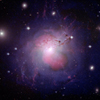CXC Home | Search | Help | Image Use Policy | Latest Images | Privacy | Accessibility | Glossary | Q&A
Tour of Perseus A
Quicktime MPEG
The giant galaxy, Perseus A, which is also known as NGC 1275, is a well-known source of strong radio radiation. This object is also a bright emitter of X-rays due to the presence of a supermassive black hole at the center of the galaxy. This mammoth galaxy lies at the center of the cluster of galaxies known as Perseus.
By combining images from several telescopes into a single composite, the dynamics of the galaxy are more easily visible. Detail and structure from X-ray, optical and radio wavelengths combine for a beautiful yet violent depiction of the events going on at the heart of the galaxy. In the composite image, the X-ray data are seen as the soft purple shells around the outside of the galaxy. The pinkish lobes toward the center of the galaxy are from radio frequencies. The radio emission, tracing jets from the black hole, fills the X-ray cavities. Dust lanes, star-forming regions, hydrogen filaments, foreground stars and background galaxies are all contributions from Hubble's optical data.
[Runtime: 01:07]
Quicktime MPEG
The giant galaxy, Perseus A, which is also known as NGC 1275, is a well-known source of strong radio radiation. This object is also a bright emitter of X-rays due to the presence of a supermassive black hole at the center of the galaxy. This mammoth galaxy lies at the center of the cluster of galaxies known as Perseus.
By combining images from several telescopes into a single composite, the dynamics of the galaxy are more easily visible. Detail and structure from X-ray, optical and radio wavelengths combine for a beautiful yet violent depiction of the events going on at the heart of the galaxy. In the composite image, the X-ray data are seen as the soft purple shells around the outside of the galaxy. The pinkish lobes toward the center of the galaxy are from radio frequencies. The radio emission, tracing jets from the black hole, fills the X-ray cavities. Dust lanes, star-forming regions, hydrogen filaments, foreground stars and background galaxies are all contributions from Hubble's optical data.
[Runtime: 01:07]
(Credit: X-ray: NASA/CXC/IoA/A.Fabian et al.; Radio: NRAO/VLA/G. Taylor; Optical: NASA/ESA/Hubble Heritage (STScI/AURA) & Univ. of Cambridge/IoA/A. Fabian)
Return to Perseus A (August 20, 2008)



